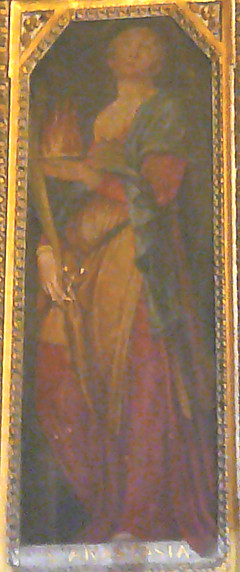HER MARRIAGE TO PUBLIUS
She was given in marriage to one Publius, but she abstained from having relations with him, feigning illness. He heard that she was going around with a servant girl dressed as a poor person and visiting Christians in prison, ministering to them in their need. So he had her locked up and refused her any food, wishing to put an end to her so he could enjoy her large fortune. Thinking she was going to die, she wrote sad letters to Chrysogonus, and he replied with letters of consolation. Then her husband died and she was freed from prison.THE THREE CHRISTIAN SERVING GIRLS
She had three beautiful serving girls who were sisters. One was called Agapete, the second Thionia, and the third Irenia. Because they were Christians they refused the advances of a certain prefect, so he shut them up in a little room where the cooking utensils were kept. Hot with love, the prefect went there to have his way with them. In his folly he thought he was grasping young women as he kissed and embraces the pots, pans, kettles, and the like. When he was sated, he left the room with his face all sooty and his clothes in tatters.When the servants who were outside waiting saw him looking like that, they thought he had changed into a demon and they gave him a beating and ran away, leaving him alone. When he went to the emperor to complain some people beat him with rods and others threw mud and dirt at him, thinking he had gone mad. His eyes had been affected, so he did not see his own deformity; it seemed to him that he and everyone else were wearing white garments. Thus he was astonished that they were all were laughing at him — him who was accustomed to being so honored. When their taunting made him realize that his appearance had changed, he thought that the girls must have done it to him by magic art, and he ordered that they be brought before him undressed so he could see them nude. But at once their clothing adhered to their bodies so that there was no way that it might be removed. Amazed at this, the prefect fell into a deep sleep. They shook him, but he could not be awakened. Finally the young women were crowned with martyrdom.
ANASTASIA IS GIVEN TO ANOTHER PREFECT
The emperor gave Anastasia to a certain prefect to have as his wife if he could make her perform the sacrifices. When the prefect led her into the bedroom and wished to embrace her, he was suddenly struck blind. He went to the gods and asked if he could be cured. They answered, “Because you have afflicted Anastasia you will be handed over to us and in a little while you will be tortured with us in hell.” And as he was heading home, he died in the hands of his servants.SHE IS GIVEN TO YET ANOTHER PREFECT
Then Anastasia was given to another prefect to be detained by him. Now this one had heard that she had a great many possessions, so privately he said to her, “Anastasia, if you want to be a Christian you may do what your God ordains. It was he who said, ‘He who has not forsaken everything that he owns, etc.’ So give me everything you have, go where you wish, and you will be a true Christian.” She answered him, “My God teaches this: ‘Sell everything you have and give it to the poor, not to the rich.’ Since you are rich, I would be going against the precepts of God if I gave you anything.” Then Anastasia was put into a terrible prison to suffer starvation. But St. Theodora, who had previously been crowned with martyrdom, brought her heavenly food for two months.HER MARTYRDOM
Finally she was taken with two hundred virgins to the Palmarian islands, where many had been exiled for the name of Christ. After a few days the prefect called them all before him and had Anastasia tied to poles and burned to death. The others he executed with various tortures. There was one of these, who for the name of Christ had suffered the loss of great riches. He told them, “At least you cannot take Christ away from me.”Apollonia buried the body of St. Anastasia in a garden, where a church was built in her honor. She died in the reign of Diocletian, which began about the year of Our Lord 287.
Golden Legend Table of Contents
Christian Iconography Home Page

St. Anastasia's attribute is a flame in a bowl or on her hand. Her status as a martyr will be signified by a palm branch in western images or a hand cross in eastern ones. (See the description page for this image and the page explaining the iconography of images of this saint.)
Permission is granted for electronic copying, distribution in print form for educational purposes and personal use. If you do reduplicate the document, indicate the sources. No permission is granted for commercial use.